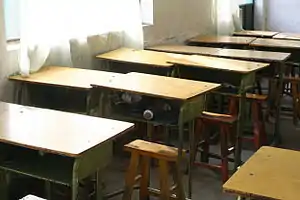Migrant School
Migrant Schools (simplified Chinese: 农民工子弟学校; traditional Chinese: 農民工子弟學校) are a type of schools for migrant students in China. The teachers and managers of these schools usually come from countryside, just as the migrant students in these schools.[1] In China, if a student want to be accepted by a primary school or secondary school, he/she must have a local household registration record ("Hukou"). However, for those migrant workers (Mingong), they and their children usually don't have local household registration record. That means their children will not be accepted by schools in the city they work in. Thus they have to send their children to "Migrant Schools" run privately.[1][2]

These "Migrant Schools" are usually low-cost. Nevertheless, these schools have many problems: Most teachers in these schools are poor-educated; The classrooms are usually crowded; Many Migrant Schools don't hold a permission issued by the authorities.[3][4] A research suggested that the education quality of these schools are far below the average.[5]
See also
References
- JAVIER C. HERNÁNDEZ; IRIS ZHAO (2017-12-24). "One Target in Beijing's Migrant Crackdown: Schoolchildren". New York Times.
- Wang, Zhengju (王正菊) (2016). 浅谈进城农民工子女教育困境的原因及对策. 小学科学(教师版) (in Chinese) (2 ed.).
- Li, Miao (李淼) (2015-05-04). 不可逾越的"人生起跑线":农民工子女的教育边缘化 (in Chinese). 文化纵横. Cite journal requires
|journal=(help) - 打工子弟学校被指"低素质":教学混乱无序 (in Chinese). 中國青年報. 2016-02-22. Retrieved 2017-12-26.
- Lai, F.; et al. (2014). "The education of China's migrant children: The missing link in China's education system". International Journal of Educational Development, 37, 68-77.
